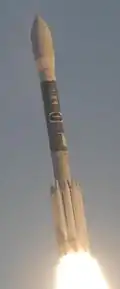Thor-Delta
The Thor-Delta, also known as Delta DM-19 or just Delta was an early American expendable launch system used for 12 orbital launches in the early 1960s. A derivative of the Thor-Able, it was a member of the Thor family of rockets, and the first member of the Delta family.[1]
 Thor-Delta prior to the launch of Explorer 10 | |
| Function | Expendable launch system |
|---|---|
| Country of origin | United States |
| Launch history | |
| Status | Retired |
| Launch sites | Cape Canaveral LC-17 |
| Total launches | 12 |
| Success(es) | 11 |
| Failure(s) | 1 |
| First flight | 1960-05-13 |
| Last flight | 1962-09-18 |
The first stage was a Thor missile in the DM-19 configuration. The second stage was the Delta, which had been derived from the earlier Able stage. An Altair solid rocket motor was used as a third stage.[2]
The basic design of the original Vanguard upper stages, featuring a pressure-fed nitric acid/UDMH, regeneratively cooled engine, was kept in place, but with an improved AJ10-118 engine. More significantly, the Delta stage featured cold gas attitude control jets allowing it to be stabilized in orbit for restart and more precise burns.
The Thor-Delta was the first rocket to use the combination of a Thor missile and a Delta upper stage. This configuration was reused for many later rockets, and a derivative, the Delta II, remained in service until 2018.
The Thor-Delta launched a number of significant payloads, including the first communications satellite, Echo 1A; the first British satellite, Ariel 1; and the first active direct-relay communications satellite, Telstar 1. All 12 launches occurred from Cape Canaveral Air Force Station Launch Complex 17. The launch of Telstar 1 used pad B, while all other launches were from pad A. All launches were successful except the maiden flight, which failed to place Echo 1 into orbit due to a problem with the second stage.
Thor-Delta launches
| No. | Date | Payload | Site | Outcome | Remarks |
|---|---|---|---|---|---|
| 1 | May 13, 1960 | Echo 1 | CCAFS LC 17A | Failure | Launch at 9:16 p.m. GMT. Good first stage. Second-stage attitude control system failure. Vehicle destroyed. |
| 2 | August 12, 1960 | Echo 1A | CCAFS LC 17A | Success | Payload placed into 1,035 miles (1,666 km), 47 degree inclination orbit. |
| 3 | November 23, 1960 | TIROS-2 | CCAFS LC 17A | Success | |
| 4 | March 25, 1961 | Explorer-10 | CCAFS LC 17A | Success | 78 pounds (35 kg) payload placed into elliptical 138,000 miles (222,000 km) orbit. |
| 5 | July 12, 1961 | TIROS-3 | CCAFS LC 17A | Success | |
| 6 | August 16, 1961 | Explorer-12 | CCAFS LC 17A | Success | Energetic Particle Explorers. EPE-A.[3] Highly elliptical orbit. |
| 7 | February 8, 1962 | TIROS-4 | CCAFS LC 17A | Success | |
| 8 | March 7, 1962 | OSO-1 | CCAFS LC 17A | Success | Orbiting Solar Observatory. 345 miles (555 km), 33 degree orbit. |
| 9 | April 26, 1962 | Ariel 1 | CCAFS LC 17A | Success | Ariel 1 was later seriously damaged by the Starfish Prime nuclear test. |
| 10 | June 19, 1962 | TIROS-5 | CCAFS LC 17A | Success | |
| 11 | July 10, 1962 | Telstar 1 | CCAFS LC 17B | Success | Telstar 1 was later damaged by the Starfish Prime high altitude nuclear event. |
| 12 | September 18, 1962 | TIROS-6 | CCAFS LC 17A | Success |
See also
References
- Wade, Mark. "Delta". Encyclopedia Astronautica. Archived from the original on 2013-05-22. Retrieved 2009-02-09.
- Krebs, Gunter. "Thor family". Gunter's Space Page. Retrieved 2009-02-09.
- "Explorer 12". NASA.
